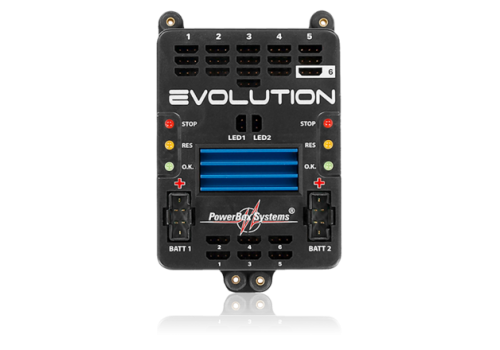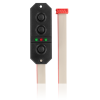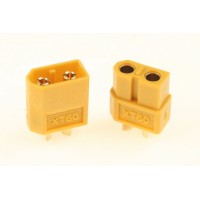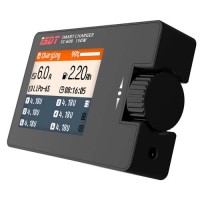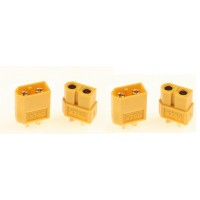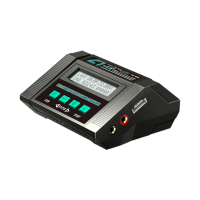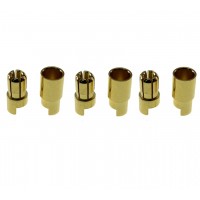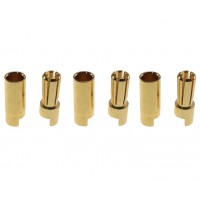PowerBox Evolution
Order No.: 4230
The PowerBox Evolution is always the first choice when a small, robust battery backer system is required: the typical range of applications extends from warbirds to 3D aerobatic models and even to jets
Features
| Technical Data
|
Set contents
- PowerBox Evolution
- SensorSwitch
- 6 patch leads
- 2 external LEDs
- 4 rubber grommets and brass spacers
- 4 retaining screws
- Operating instructions in german and english
Product description
| |||||
Movies for PowerBox Evolution
PowerBox product range RUS - Part 1 Introduction in PowerBox products in Russian language |
Downloads
| Reviews
|
PowerBox - Evolution Order No.: 4230
- Product Code: 4230 PowerBox Evolution
- Availability: 2 - 3 Days, email to order
- AerobatX Product ID: 275
- £198.00
-
£170.28
- Ex Tax: £141.90
Related Products
Plugs - Deans T style
Deans Style plugs - 1 MALE and 1 FEMALE connectors per pack with plastic sleeves..
£1.00 Ex Tax: £0.83
Plugs - XT60
Description: SOLD as 1 pair These connectors are made from high-temp nylon with gold-pla..
£1.00 Ex Tax: £0.83
Plugs - EC5, 2 pairs
Description: SOLD as 2 pairs Capable of more than 120A continuous current..
£4.00 Ex Tax: £3.33
Plugs - EC3
Description: SOLD as 2 pairs Capable of 60 continuous amps Ergonomi..
£2.00 Ex Tax: £1.67
Plugs - 3.0mm Bullet connecters
3.0mm bullet / banana connecters for ESC / electric motors - packs of 3 pairs ( male and female)&nbs..
£2.00 Ex Tax: £1.67
Plugs - 3.5mm Bullet connecters
3.5 mm bullet / banana connecters for ESC / electric motors - packs of 3 pairs ( male and female)&nb..
£2.00 Ex Tax: £1.67
Plugs - 4.5mm Bullet connecters
4.5 mm bullet / banana connecters for ESC / electric motors - packs of 3 pairs ( male and female)&nb..
£2.00 Ex Tax: £1.67
Charger - ISDT SC608 150 Watt Charger
2.4" IPS Display262K colors Hi-brightness monitor, up to 178°visible angle, brings outstanding displ..
£0.00 Ex Tax: £0.00
Charger - ISDT Q6 Plus 300 Watt Charger
DESCRIPTIONThe ultimate field charger JUST GOT SMALLER which can run off an external power..
£0.00 Ex Tax: £0.00
Plugs - XT60 - 2 pairs
Description: SOLD in 2 pairs These connectors are made from high-temp nylon with gold-pl..
£2.00 Ex Tax: £1.67
Charger - C1-XR Balance charger
AC Input voltage100-240VDC Input Voltage11-18VCharge powermax.100WDischarger powermax.5WCharge curre..
£0.00 Ex Tax: £0.00
Plugs - 4.0mm Bullet connecters
4.0mm bullet / banana connecters for ESC / electric motors - packs of 3 pairs ( male and female)&..
£2.00 Ex Tax: £1.67
Plugs - 6.0mm Bullet connecters
6.0mm bullet / banana connecters for ESC / electric motors - packs of 3 pairs ( male and female)&nbs..
£6.00 Ex Tax: £5.00
Plugs - XT30 - 2 pairs
Description: SOLD in 2 pairs XT30 Battery Connector SetXT30 is perfect for Mini RC use. For..
£2.00 Ex Tax: £1.67
Plugs - XT90 - 1 pairs
Description: SOLD in 1 pair These connectors are made from high-temp nylon with gold-pla..
£3.00 Ex Tax: £2.50
Plugs - 5.0mm Bullet connecters
5.0 mm bullet / banana connecters for ESC / electric motors - packs of 3 pairs ( male and female)&nb..
£5.00 Ex Tax: £4.17
Plugs - 5.5mm Bullet connecters
5.5 mm bullet / banana connecters for ESC / electric motors - packs of 3 pairs ( male and female)&nb..
£5.00 Ex Tax: £4.17

